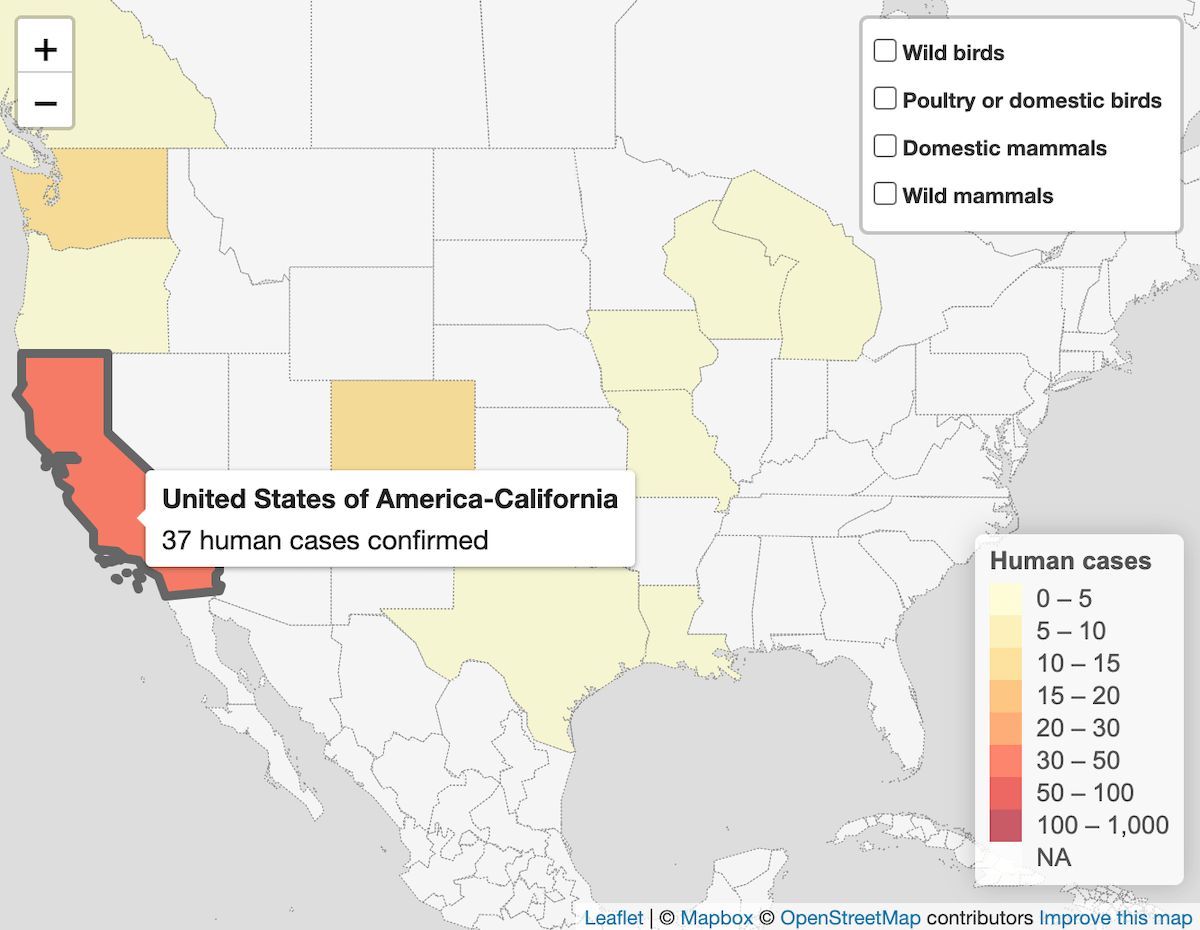New Map Tracks Bird Flu Cases as U.S. Reports First Human Death

Human bird flu cases are increasing across the country. The H5N1 virus primarily infects poultry and mammals but can be transmitted to humans via direct contact with sick animals, per the Centers for Disease Control and Prevention (CDC). As of Jan. 8, 2025, there have been 70 confirmed human bird flu cases in the U.S. since 2022. The World Health Organization (WHO) reports that half of global cases of H5N1 end in death. There’s no doubt that human bird flu is spreading, and now, there’s an interactive map that can help monitor human- and animal-related cases in real-time.
RELATED: COVID Levels are “Very High” and “High” in These 28 States After Holiday Surge.
A new interactive map monitors bird flu cases in real-time.

Tracking bird flu cases in the U.S. just got a whole lot easier for both scientists and the public. This week, the Pan American Health Organization (PAHO) unveiled a new interactive dashboard that “features tables and maps showing outbreaks in humans, as well as in domestic and wild birds and mammals across the region, the latter with data sourced from the World Organization for Animal Health (WOAH),” per a press release.
By stepping up its “active surveillance efforts,” the PAHO hopes to slow down and prevent the spread of influenza H5N1 from infected animals to humans.
The tool has three main categories: human-confirmed cases, number of bird outbreaks, and number of mammal outbreaks. These are routinely updated but can also be filtered to show specific data points from certain periods.
Each section also has its own interactive map, which organizes the number of confirmed cases or outbreaks by country and/or state. For instance, the four U.S. states with the most confirmed cases of human bird flu are California (37), Washington (11), Colorado (10), and Michigan (2).
RELATED: Cat Food Sold Nationwide Recalled After Testing Positive for Bird Flu.
Louisiana just reported the first human death from bird flu in the U.S.
A person in Louisiana died after being hospitalized due to a “severe” case of bird flu, the CDC confirmed in a Jan. 6 press release. The agency called their passing “tragic” yet “not unexpected” given the disease’s known potential to “cause severe illness and death.” The deceased, who remains anonymous, is the first person in the U.S. to die from bird flu.
“CDC has carefully studied the available information about the person who died in Louisiana and continues to assess that the risk to the general public remains low. Most importantly, no person-to-person transmission spread has been identified,” reads the statement.
RELATED: Flu Levels Are “Very High” and “High” in These 14 States.
8 common bird flu symptoms.
Fortunately, most human cases of bird flu in the U.S. have been mild, reports the CDC.
Common symptoms that have been associated with the illness include:
- Eye redness/irritation
- Mild fever
- Cough
- Sore throat
- Runny or stuffy nose
- Muscle and body aches
- Headache
- Fatigue
Diarrhea, nausea, and vomiting may also occur, though these symptoms aren’t as common. In more advanced cases, infected people may experience shortness of breath/difficulty breathing, altered consciousness, and seizures.
Bird flu has an incubation period of about two to seven days, per the CDC. Typically, eye symptoms are the first to show up and can do so within 24 hours of exposure. Experts say more research is needed to know the exact “period of contagiousness,” but it’s likely to be “during the first few days of their illness.”
On average, bird flu lasts anywhere from “a few days to less than two weeks,” according to the CDC. However, symptoms may persist for several weeks or worsen in more severe cases. As always, speak with a healthcare professional if you believe you’ve been exposed to bird flu and are exhibiting symptoms.